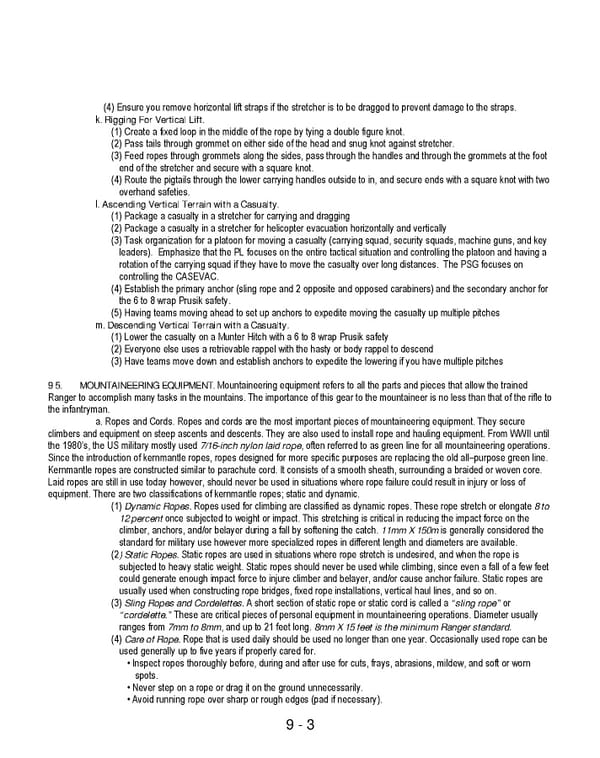9 - 3 (4) Ensure you remove horizontal lift straps if the stretcher is to be dragged to prevent damage to the straps. k. Rigging For Vertical Lift. (1) Create a fixed loop in the middle of the rope by tying a double figure knot. (2) Pass tails through grommet on either side of the head and snug knot against stretcher. (3) Feed ropes through grommets along the sides, pass through the handles and through the grommets at the foot end of the stretcher and secure with a square knot. (4) Route the pigtails through the lower carrying handles outside to in, and secure ends with a square knot with two overhand safeties. l. Ascending Vertical Terrain with a Casualty. (1) Package a casualty in a stretcher for carrying and dragging (2) Package a casualty in a stretcher for helicopter evacuation horizontally and vertically (3) Task organization for a platoon for moving a casualty (carrying squad, security squads, machine guns, and key leaders). Emphasize that the PL focuses on the entire tactical situation and controlling the platoon and having a rotation of the carrying squad if they have to move the casualty over long distances. The PSG focuses on controlling the CASEVAC. (4) Establish the primary anchor (sling rope and 2 opposite and opposed carabiners) and the secondary anchor for the 6 to 8 wrap Prusik safety. (5) Having teams moving ahead to set up anchors to expedite moving the casualty up multiple pitches m. Descending Vertical Terrain with a Casualty. (1) Lower the casualty on a Munter Hitch with a 6 to 8 wrap Prusik safety (2) Everyone else uses a retrievable rappel with the hasty or body rappel to descend (3) Have teams move down and establish anchors to expedite the lowering if you have multiple pitches 9 5. MOUNTAINEERING EQUIPMENT. Mountaineering equipment refers to all the parts and pieces that allow the trained Ranger to accomplish many tasks in the mountains. The importance of this gear to the mountaineer is no less than that of the rifle to the infantryman. a. Ropes and Cords. Ropes and cords are the most important pieces of mountaineering equipment. They secure climbers and equipment on steep ascents and descents. They are also used to install rope and hauling equipment. From WWII until the 1980’s, the US military mostly used 7/16-inch nylon laid rope, often referred to as green line for all mountaineering operations. Since the introduction of kernmantle ropes, ropes designed for more specific purposes are replacing the old all–purpose green line. Kernmantle ropes are constructed similar to parachute cord. It consists of a smooth sheath, surrounding a braided or woven core. Laid ropes are still in use today however, should never be used in situations where rope failure could result in injury or loss of equipment. There are two classifications of kernmantle ropes; static and dynamic. (1) Dynamic Ropes. Ropes used for climbing are classified as dynamic ropes. These rope stretch or elongate 8 to 12 percent once subjected to weight or impact. This stretching is critical in reducing the impact force on the climber, anchors, and/or belayer during a fall by softening the catch. 11mm X 150m is generally considered the standard for military use however more specialized ropes in different length and diameters are available. (2) Static Ropes. Static ropes are used in situations where rope stretch is undesired, and when the rope is subjected to heavy static weight. Static ropes should never be used while climbing, since even a fall of a few feet could generate enough impact force to injure climber and belayer, and/or cause anchor failure. Static ropes are usually used when constructing rope bridges, fixed rope installations, vertical haul lines, and so on. (3) Sling Ropes and Cordelettes. A short section of static rope or static cord is called a “sling rope” or “cordelette.” These are critical pieces of personal equipment in mountaineering operations. Diameter usually ranges from 7mm to 8mm, and up to 21 feet long. 8mm X 15 feet is the minimum Ranger standard. (4) Care of Rope. Rope that is used daily should be used no longer than one year. Occasionally used rope can be used generally up to five years if properly cared for. • Inspect ropes thoroughly before, during and after use for cuts, frays, abrasions, mildew, and soft or worn spots. • Never step on a rope or drag it on the ground unnecessarily. • Avoid running rope over sharp or rough edges (pad if necessary).
 Ranger Handbook Page 170 Page 172
Ranger Handbook Page 170 Page 172